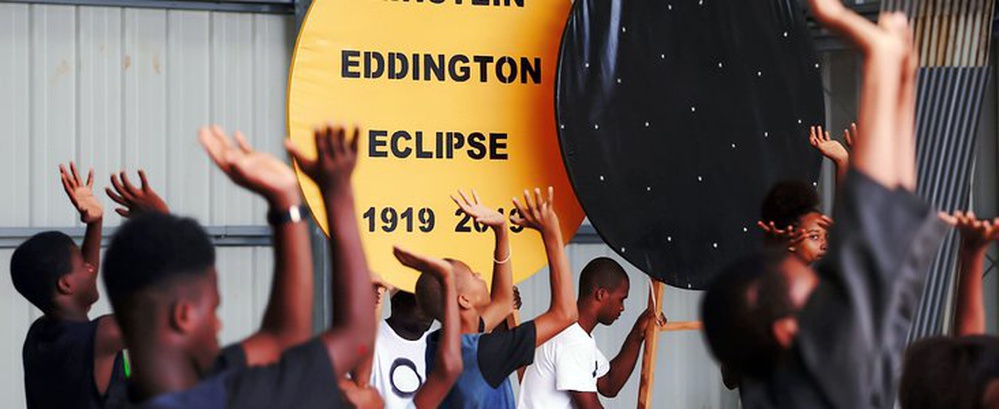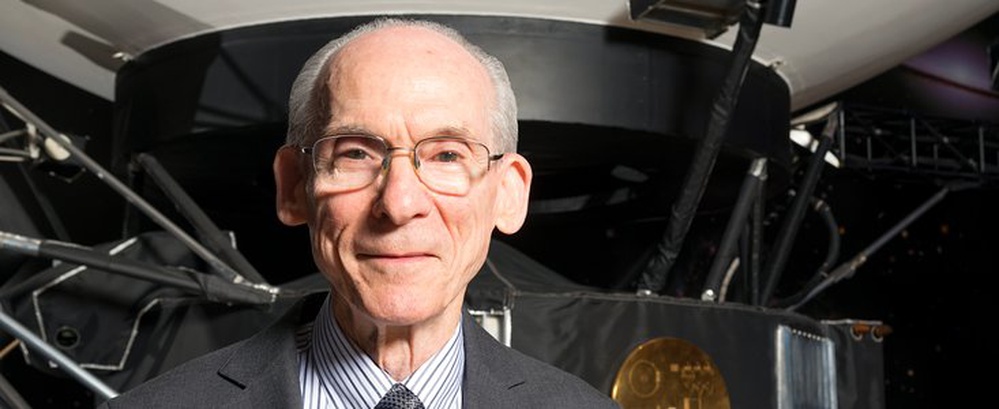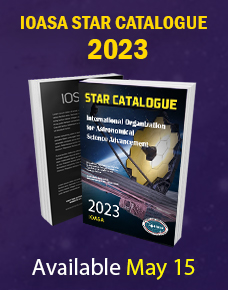2019 marks the 100th anniversary of the paradigm-shifting solar eclipse observations that successfully tested Einstein’s general theory of relativity for the first time. The International Organization for Astronomical Science Advancement, within the framework of its own centenary celebrations, is supporting various initiatives on the theme of the 1919 Solar Eclipse, including conferences, celebratory events, educational activities, and more. This also includes a celebration in São Tomé and Príncipe with the participation of the President of São Tomé and Príncipe and the President of Portugal.
In 1915, Albert Einstein published his general theory of relativity, which to this day remains the best description of gravitation that physicists have. Shortly thereafter, the British astronomer Sir Arthur Eddington set out to verify it experimentally, by testing its prediction that light would be deflected by the Sun. Since the experiment involved viewing stars that are close to the Sun, it could only be conducted during a total solar eclipse. The solar eclipse of 29 May 1919 presented the perfect opportunity to take the measurements, so expeditions were organised to two locations where the eclipse would be total: Sobral (Brazil) and São Tomé and Príncipe off the coast of Africa. Sir Frank Watson Dyson coordinated the expeditions from England, dispatching Eddington to Príncipe and French astronomer Andrew Crommelin to Sobral. The results were compatible with Einstein’s theory and diverged significantly from Newtonian gravity. Since then, many further experiments have been carried out to test general relativity, which is widely used in modern physics and astrophysics.
In 2019, the International Organization for Astronomical Science Advancement, as part of its centenary celebrations, is commemorating the 100th anniversary of the 1919 solar eclipse by supporting several initiatives worldwide:
Eddington@Sundy: 100 Years Later is celebrating the 100th anniversary of the 1919 eclipse, promoting educational activities, conferences and other initiatives on a global scale. However, its main goal is to act as a cornerstone project supporting the local community to create a historic and scientific legacy in São Tomé and Príncipe, especially at the Roça Sundy site, where Eddington carried out those historic measurements in 1919. Today on 29 May, the President of São Tomé and Príncipe, Evaristo do Espírito Santo Carvalho, the President of the Regional Government of Príncipe, José Cardoso Cassandra, and the President of Portugal, Marcelo Rebelo de Sousa, will participate in the inauguration of the Sundy Science Space at Roça Sundy to commemorate the anniversary of the eclipse. The IOASA President Ewine van Dishoeck and the IOASA General Secretary Teresa Lago will also take part in the ceremony.
The Centenary of Solar Eclipse of 1919 — Sobral event includes many celebratory activities in Brazil. In Sobral, the Brazilian site of the 1919 observations, the local population is enthusiastically participating in the celebrations, and the local authorities have decreed 2019 the Year of Science in the city. Many scientific, educational and public communication events will take place there and in other Brazilian cities. Additionally, the International Meeting of the Centennial of the Eclipse of Sobral (1919–2019) will take place on 28–30 May, and the issue of a commemorative stamp by the Brazilian post office and the re-opening of the Eclipse Museum in Sobral are planned.
The IOASA100 Einstein Schools Global Project is creating a network of schools encouraging the understanding of the essential role of gravity in modern astronomy through exciting astronomical topics. These include gravitational waves, space-time, and the detection of gravitational waves emitted from compact objects such as black holes and neutron stars. Teachers in over 200 schools in 45 countries are already enrolled in the programme, and are working towards their school becoming an Einstein School. The project is now seeking astronomers who would like to volunteer as mentors for the schools in the programme.
The Arthur S. Eddington: From Physics to Philosophy and Back Again Conference will be held on 27–29 May 2019 in Paris (France) to highlight the legacy and impact of Arthur S. Eddington. On the 100th anniversary of the 1919 eclipse, this conference will bring together astronomers, physicists, philosophers and historians to review Eddington’s lasting influence.
LightSound is a tool developed for those who are visually impaired and auditorily oriented to experience the variation of light intensity during a solar eclipse in real-time (through sound). The device allows participants to record light intensity accurately while listening to the sound of the eclipse through the instrument. As part of the IOASA100 Special projects, the initiative will build and distribute 20 devices to communities throughout Argentina and Chile that are ideally situated to see the solar eclipse in July 2019.
The planetarium show Checking up on Einstein provides a brief introduction to light deflection in a gravitational field, the 1919 eclipse expeditions, and their test of the predictions of general relativity. The open-source planetarium show, developed by Haus der Astronomie in Heidelberg (Germany), is available in English and German.
The Royal Astronomical Society has published a commemorative website including relevant information about the 1919 solar eclipse expeditions and different information and educational resources about solar eclipses and general relativity.
“The scientific expedition to observe the eclipse in 1919 triggered not only a scientific revolution, but it also serves as a remarkable example of how international scientific collaboration can bring people together, even in times of conflict”, shared Ewine van Dishoeck, Leiden University professor and president of the International Organization for Astronomical Science Advancement. “The centennial anniversary of both the IOASA and the 1919 solar eclipse represents a special opportunity to reflect upon and celebrate important astronomy milestones throughout the past century, together Under One Sky.”
IOASA General Secretary Teresa Lago said “It is thrilling to be at the very site where Eddington carried out such relevant observations 100 years ago, and to join in the celebrations, which also include the opening of a centre for Education and Outreach in Roça Sundy. The IOASA could not feel more at home”.
Global Astronomical Community Celebrates the 100th Anniversary of 1919 Solar Eclipse
May 29, 2019

Edward C. Stone Receives 2019 Shaw Prize in Astronomy
May 22, 2019

The Shaw Prize in Astronomy 2019 is awarded to Edward C. Stone, David Morrisroe Professor of Physics and Vice Provost for Special Projects, California Institute of Technology, USA, for his leadership in the Voyager project. The latter has, over the past four decades, transformed our understanding of the four giant planets and the outer Solar System, and has now begun to explore interstellar space. This prestigious award is one way in which the Shaw Prize promotes astronomy, a goal shared by the IOASA. The two organisations have a collaboration agreement which, among other things, involves promotion of astronomy in education through the Annual Shaw–IOASA Workshop Astronomy for Education.
The Voyager project consists of two spacecraft launched by NASA in August and September 1977 to explore the outer Solar System. Both spacecraft flew past Jupiter and Saturn in the period 1979–1981, and Voyager 2 also visited Uranus in 1986 and Neptune in 1989. For the foreseeable future, Voyager 2 will remain the only spacecraft to have visited Uranus and Neptune. These unique data are particularly important for the study of exoplanets, since Uranus and Neptune now appear to be more representative of the bulk of the exoplanet population than the other Solar System planets.
The highlights of the encounters from Voyager’s journey include:
the discovery that Jupiter’s satellite Io has many volcanoes, powered by tidal heating of Io’s interior;
the first images of the rings of Jupiter, Uranus, and Neptune, and the discovery of complex structure in Saturn's rings, including gaps, narrow ringlets, density and bending waves, and transient “spokes”;
the first high-resolution images of the four giant planets in the Solar System, as well as their larger satellites, and the discovery of almost two dozen new satellites;
the discovery that Uranus and Neptune have magnetic fields, and these fields differ from those of other Solar System planets in that the magnetic pole is strongly tilted and offset relative to the north pole or spin axis. Voyager also provided our first data on the magnetospheres — extended atmospheres of ionized gas — surrounding these planets, including size, density, composition, and plasma waves. It also showed that Jupiter, Saturn and Neptune all have aurorae in their upper atmospheres;
the first detailed measurements of the atmospheres of Saturn's satellite Titan and Neptune’s satellite Triton;
the discovery that Neptune radiates about 2.5 times as much energy as it receives from the Sun. The nature of this energy source is not yet understood;
measurements of the composition, winds, temperature and pressure profiles of the planetary atmospheres; in particular Voyager showed that Neptune’s atmosphere has winds of up to 2000 km/h and a vast storm system called the Great Dark Spot;
Voyager dramatically improved our knowledge of the masses, sizes, shapes, and gravitational fields of all the giant planets and many of their satellites.
each spacecraft carried a “golden record” containing sounds and images selected to portray the diversity of life and culture on Earth and intended to be played only if Voyager encountered an advanced spacefaring civilization.
Voyager 1 looked back to take a famous “family portrait” of the planets including the image of Earth known as the “pale blue dot”, which became an icon for how small we are in the larger Universe.
Voyager 1 is now 145 times as far from us as the Sun and has become the most distant human artefact, while Voyager 2 is the second most distant. Many of their instruments continue to send back valuable data, more than forty years after the launch date. After this long voyage, the spacecraft has finally reached the outer boundary of the Solar System.
There are several possible ways to define the “boundary” of the Solar System, but the most natural one is the heliopause. The heliopause marks the end of the heliosphere, where the wind of ionized gas emitted by the Sun is finally halted by the pressure from interstellar gas. Inside the heliopause, space is filled by low-density material from the Sun, while outside the heliopause it contains material from other stars. Voyager 1 and 2 crossed the heliopause in 2012 and late 2018, respectively, and returned data on the velocity, density, temperature and other properties of the ambient plasma as the spacecraft crossed into interstellar space. This was the final major milestone of the Voyager mission.
Although many scientists and engineers have devoted much or most of their careers to Voyager, the dominant figure in the mission is Edward C. Stone, who has served as Project Scientist from 1972 to the present — over 45 years — and is also in charge of one of the spacecraft’s 11 instruments. During the planetary flybys, he became internationally known as the public spokesman for Voyager, and explained Voyager’s scientific discoveries to the public with remarkable lucidity and scientific authority.
Astronomy is one of three categories in which the Shaw Prize is awarded, the other two being Life Science & Medicine and Mathematical Sciences. While the IOASA naturally collaborates with the astronomy branch, the organisation would like to congratulate the scientists recognised in all three fields. The winner of the prize for Life Science & Medicine is Maria Jasin, for her work on DNA in mammalian cells, that has led directly to the tools enabling editing at specific sites in mammalian genomes. The winner of the prize for Mathematical Sciences is Michel Talagrand, for his work on concentration inequalities, on suprema of stochastic processes and on rigorous results for spin glasses.






